Resources
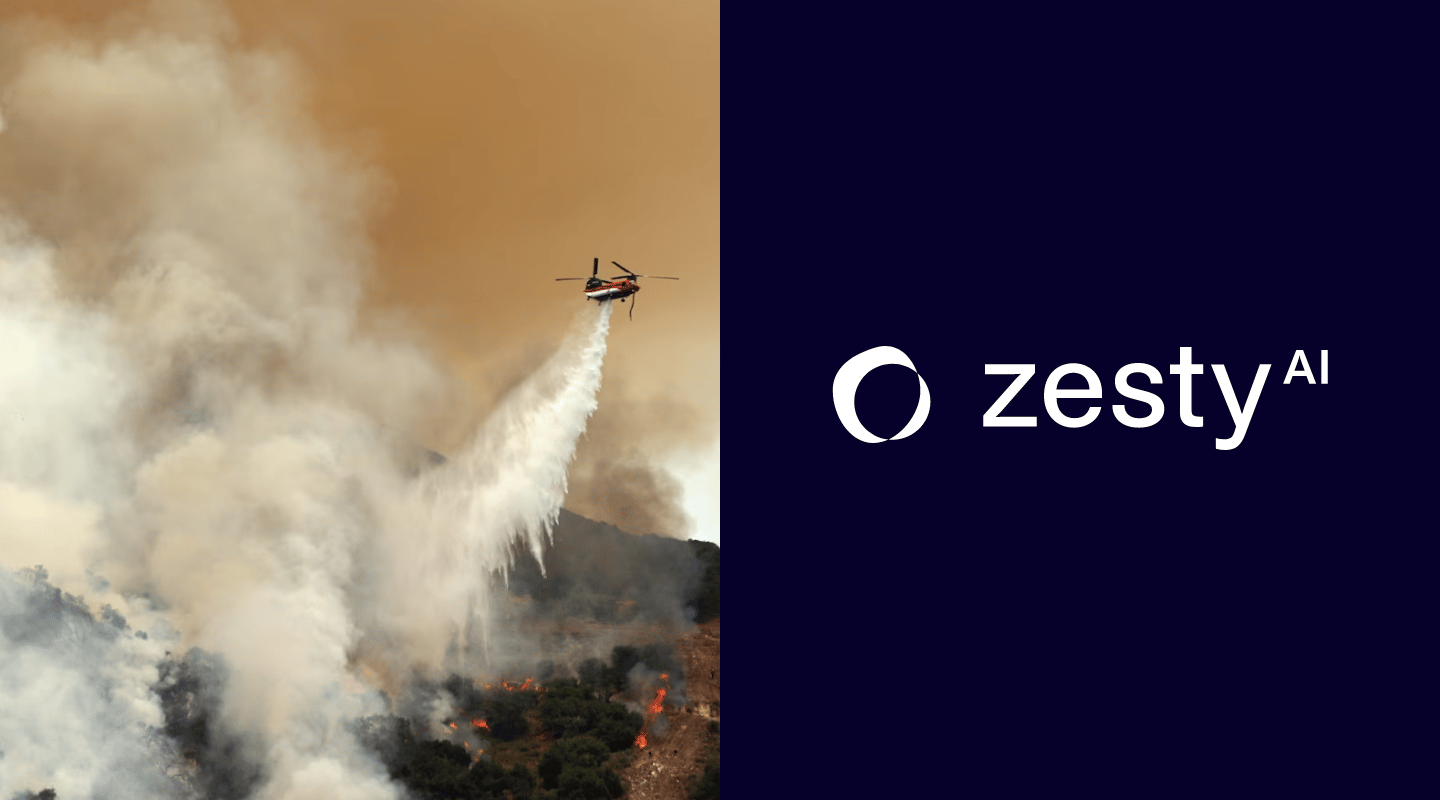
Wildfire Season Update: July Blazes Highlight Risk and Mitigation Strategies
Z-FIRE analysis reveals vulnerability in wildfire zones – 100% of properties were at "Very High" risk
The current wildfire season underscores the importance of proactive risk management. With hot, dry conditions prevailing across the western US, July has seen numerous wildfires erupt, echoing our earlier predictions in our research, "Wildfire Season Overview: Not Just a California Problem."
The Current Wildfire Situation
Fortunately, most current incidents have been in remote areas that have a lower risk of loss of life and property. So far, it appears these fires have not been nearly as deadly as the South Fork Fire near Ruidoso, New Mexico, in June.
However, the destruction has still been sizeable. California’s largest wildfire so far this year, the Lake Fire near Santa Barbara, started on July 5th and has consumed an estimated 38,000 acres. It remains at only 34% contained, according to Cal Fire. The French Fire in Mariposa County, California, which ignited July 4th, shut down a major thoroughfare into Yosemite National Park, which has since been reopened. The fire has burned about 900 acres of grass, oak woodland, and brush; it left 4 people injured and destroyed 11 structures.
As we predicted, it’s not just a California problem. More than 750 firefighters are working to contain the Salt Creek Fire in Southwest Oregon, which ignited July 7th currently stands at over 4,000 acres consumed. It is 41% contained. And on the Washington/Idaho border, the Billy Creek Fire has reached 74% containment, having burned over 3,000 acres. Fortunately, most structures are a mile or more outside of the perimeter.
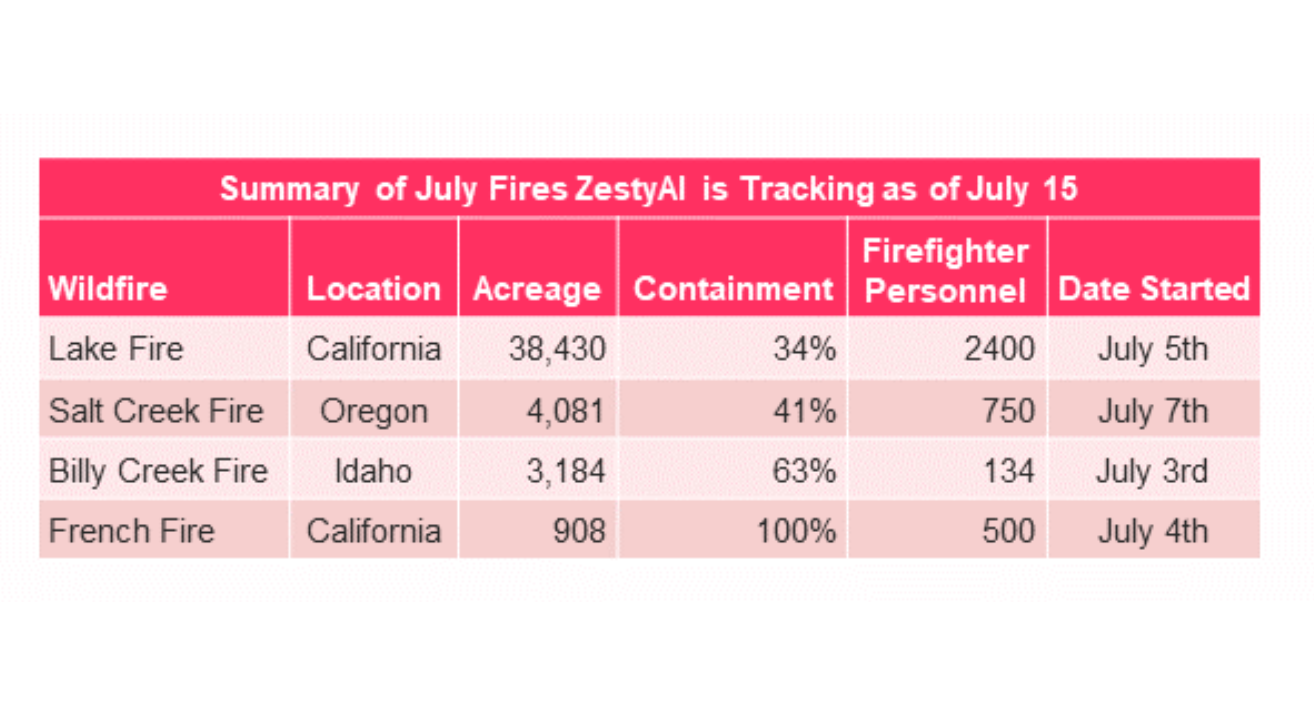
Predicting Wildfire Risk With Accuracy
ZestyAI's Z-FIRE wildfire model leverages AI and historical wildfire data to predict neighborhood and property-level wildfire risk across the US. This comprehensive model helps insurance companies understand loss risk and collaborate with policyholders on mitigation strategies.
There are three components of Z-FIRE:
- Level 1 Score (L1): Predicts the likelihood of a property being located within a wildfire perimeter over the next year.
- Level 2 Score (L2): The conditional probability of a property being destroyed if within a wildfire perimeter.
- Risk Factor Analysis: Provides insights into factors influencing L1 and L2 scores.
Z-FIRE Analysis of Recent Fires
We analyzed the fire perimeters of four major July wildfires: Billy Creek (Idaho), Salt Creek (Oregon), French (California), and Lake (California). This analysis will be revisited for a complete assessment in our annual Z-FIRE performance memo.
L1 Results: Very High Risk Confirmed
L1 scores identified "Very High" risk for all properties within the fire perimeters. Notably, 100% of properties within fire zones were classified as "Very High" risk, compared to just 3% nationally. This information is crucial for implementing appropriate mitigation strategies by insurance carriers and property owners.
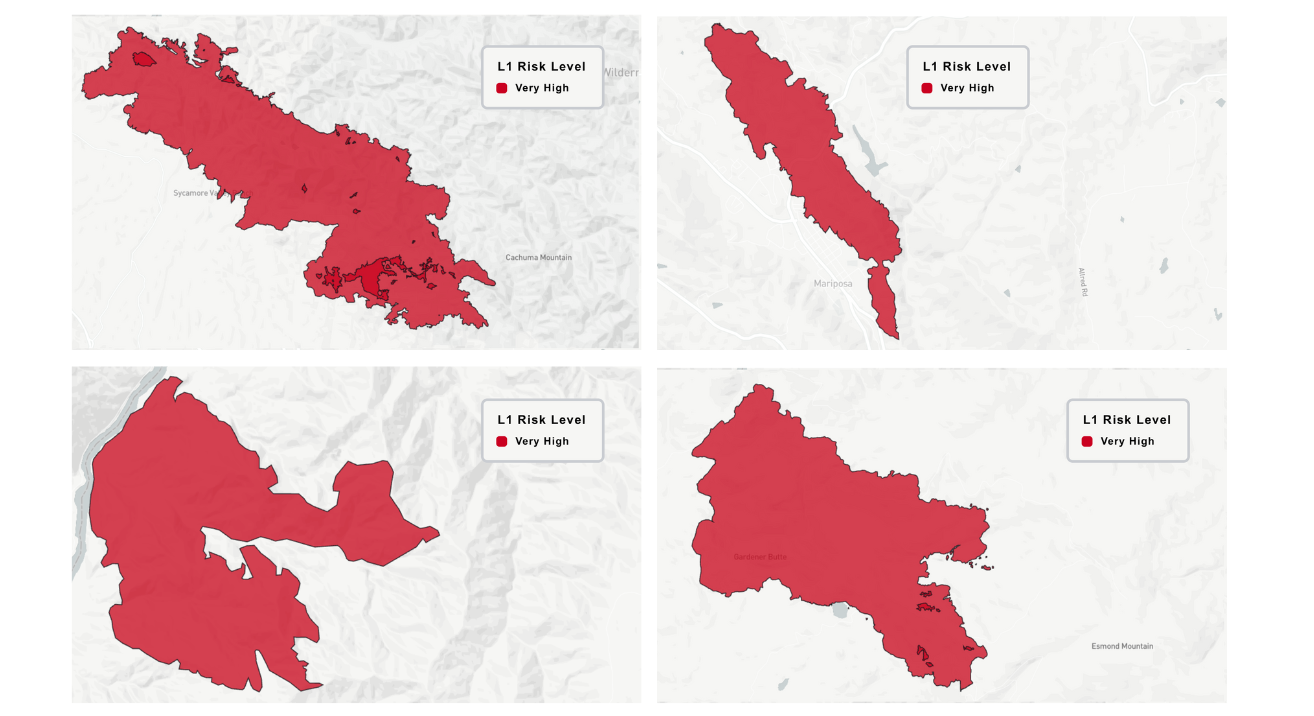
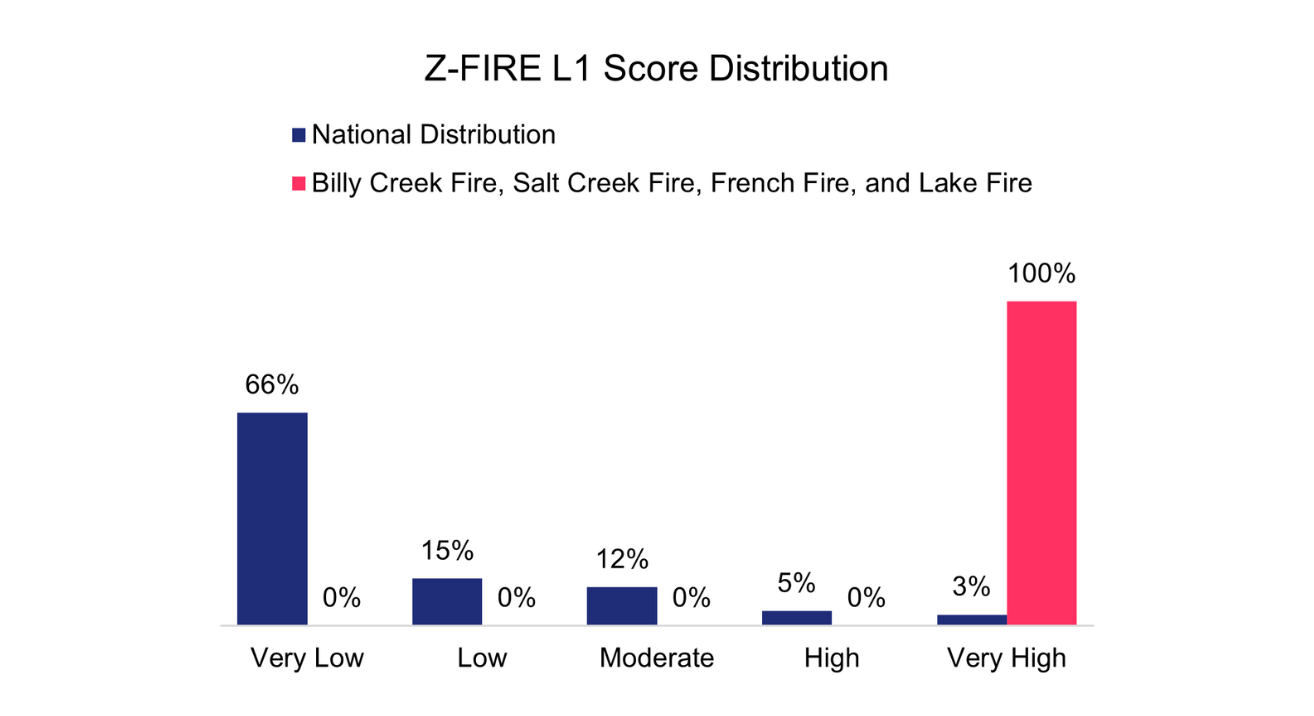
L2 Reveals Elevated Risk to Structures

The Z-FIRE L2 score predicts the likelihood of each property being destroyed when included in a wildfire perimeter. We analyzed the properties within the French Fire perimeter for L2 risk, as this fire included the most structures at risk of being consumed (39).
We found that the properties within the French Fire perimeter were at higher risk than California at large. Approximately three-quarters of properties were classified as “High” or “Very High” risk for destruction versus less than half of properties across California. For the French Fire, about a quarter was within the “Low” or “Moderate” risk categories. Notably, no properties were considered “Very Low” risk, while 14% of all California properties are in this category.
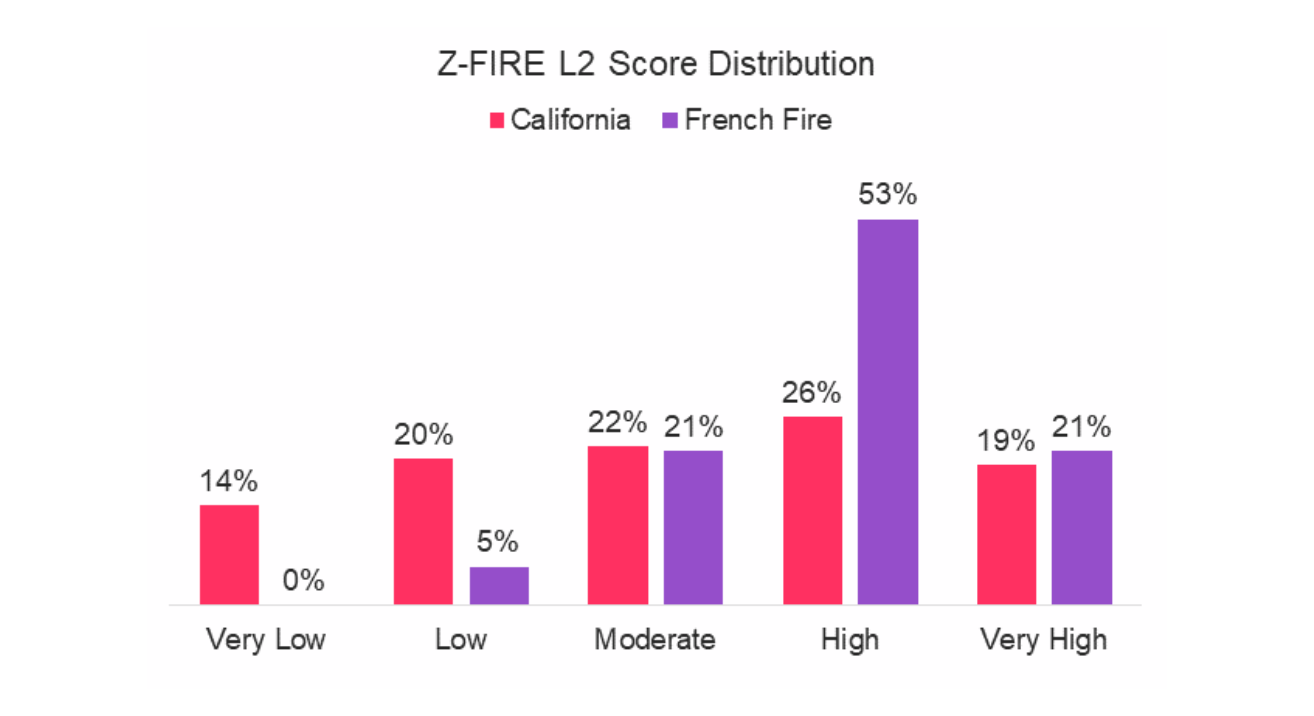
This underscores the importance of property-specific characteristics and maintenance undertaken by property owners, like maintaining defensible space and upgrading building materials for fire resiliency. As we found in our research co-authored by the Insurance Institute for Business & Home Safety (IBHS), fuel reduction efforts, such as trimming nearby vegetation and maintaining a defensible space, can increase the likelihood of a structure surviving by 100%. While the entire French Fire area exhibited high wildfire risk, mitigation efforts undertaken by property owners can significantly reduce a structure's risk.
After the French Fire is fully contained, we’ll analyze L2 score performance in predicting which structures survived as part of our 2024 Z-FIRE performance memo.
A Stark Reminder: Mitigation is Critical
The science is clear: reducing fuel around a property significantly increases its chances of surviving a wildfire. Individual property owners and entire communities play a critical role in fire risk. To learn more, explore our full research report, "Wildfire Fuel Management and Risk Management," along with our 2024 Wildfire Season Overview.
Note: Wildfire situations are constantly evolving. The figures and analysis presented here may change as fire perimeters evolve and containment increases.

Now Available: The Insurers Guide to Roof Risk
Learn how leading insurers are mastering roof risk and maximizing lift
It’s hard to overstate how important the roof is from an insurability standpoint. The roof represents significant risks and potential opportunities, making it a critical focus area for insurers. This has become even more important in recent years as the impact of severe convective storms is often reflected in roof losses. Understanding this, ZestyAI has released new research for property insurers called The Insurers Guide to Roof Risk.
Download The Insurers Guide to Roof Risk
In an era where the severity and frequency of roof-related claims are on the rise, particularly due to the increasing impact of severe convective storms, innovative tools and strategies are essential. The Insurers Guide to Roof Risk provides actionable insights to improve risk assessment, underwriting processes, and overall business strategy.
What’s Inside the Guide?
The Insurers Guide to Roof Risk includes:
- Roof Failure Factors: Learn the underlying contributing factors behind why older roofs fail more often.
- Beyond Roof Age: Discover why roof complexity, condition, and climate are more important than roof age alone.
- Identifying Missing Risk Factors: Understand the key factors to roof risk that most traditional models miss.
- Advanced Risk Segmentation: See how using machine learning and new data sources can split risk more than 60 times better than traditional models.
- Portfolio Optimization: Access a comprehensive toolbox to optimize your portfolio and new business selection to generate exponential lift versus traditional models.
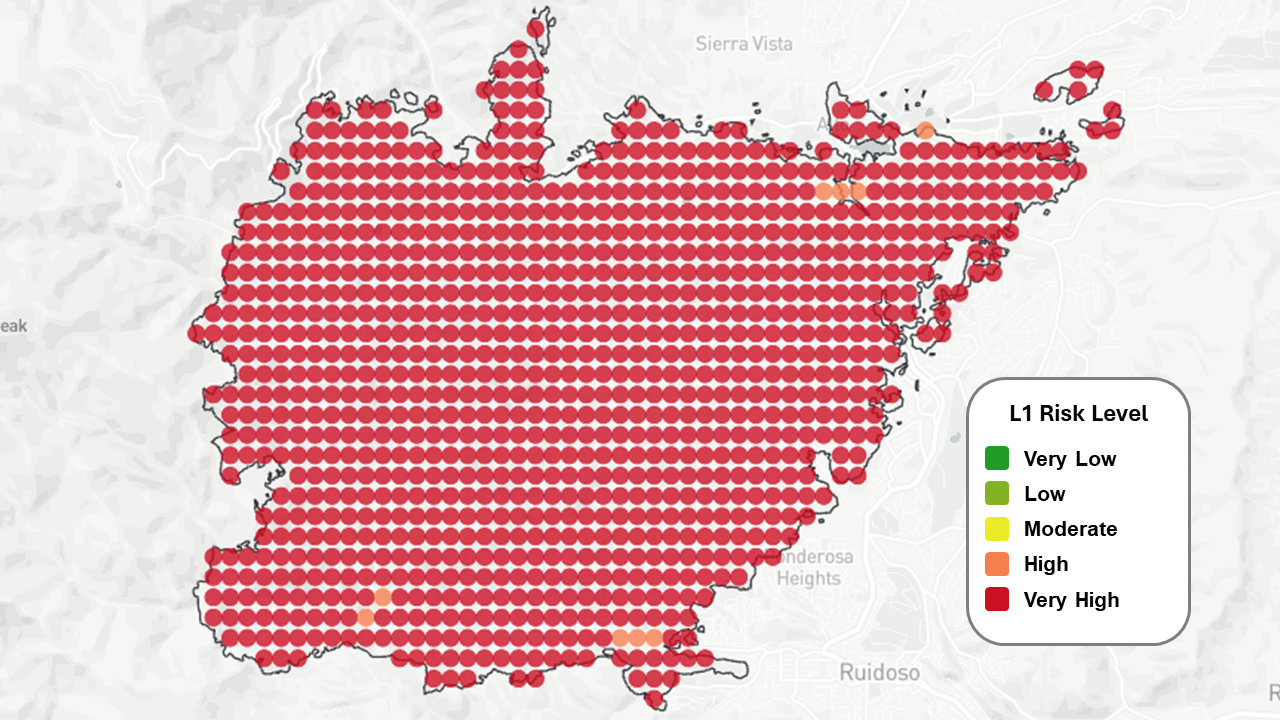
As Ruidoso Recovers, Z-FIRE Helps Communities Prepare for Wildfires
Z-FIRE found that 100% of properties within the fire zone were classified as High or Very High risk
Residents of Ruidoso, New Mexico, received positive news this week as authorities lifted evacuation orders for thousands following the devastation caused by the South Fork and Salt fires. While a significant portion of the community remains inaccessible, this development marks a crucial step in recovery.
As of June 27th, the South Fork Fire is 69% contained and has burned over 17,000 acres. The Salt Fire, at 66% containment, has consumed nearly 8,000 acres. Over 1,100 firefighters from various states are battling the blazes. Tragically, these wildfires have resulted in at least two confirmed fatalities and the destruction of over 1,400 structures.
New Mexico Identified as High-Risk State in ZestyAI’s 2024 Wildfire Season Overview
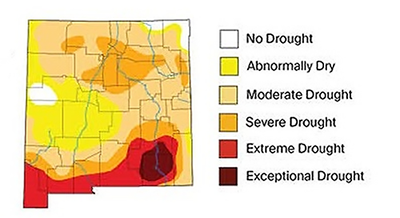
Earlier this year, our May research study, "2024 Wildfire Season Overview: Not Just a California Problem," identified New Mexico as a state with concerning wildfire conditions. Alongside Arizona, Northern Idaho, and Western Montana, the report highlighted these regions as areas susceptible to significant wildfires in 2024, particularly in the absence of substantial precipitation to alleviate existing drought conditions.
(Figure: UNL U.S. Drought Monitor for New Mexico, April 16 2024)
Z-FIRE: A Tool for Proactive Wildfire Risk Management
Wildfire risk assessment solutions like Z-FIRE can empower insurance carriers and property owners to mitigate potential losses. Z-FIRE leverages artificial intelligence to predict wildfire risk at both the neighborhood and individual property levels across the United States. Z-FIRE is trained on a national dataset and delivers risk scores for all residential and commercial properties across the contiguous US. It offers a multi-layered approach:
- Level 1 Score: (L1) Neighborhood Score: Predicts the likelihood of a property being located within a wildfire perimeter over the next year.
- Level 2 Score: (L2) Property-Specific Score: Conditional probability of a property sustaining damage if included within a wildfire perimeter.
- Risk Factor Analysis: Provides insights into the key drivers influencing both L1 and L2 scores.
Z-FIRE Analysis of the South Fork Fire Perimeter
We applied Z-FIRE to the South Fork Fire perimeter to assess the effectiveness of the risk scores in predicting fire risk within that region. We used the fire perimeter as of June 18th; note that these analytics will change as the fire perimeter changes and the fire becomes fully contained. We will do a full assessment as part of our 2024 Z-FIRE performance memo, analyzing model performance across all fires and all states.
L1 Reveals High Risk
The L1 scores indicated a very high risk of properties being included within a wildfire perimeter. Notably, 100% of properties within the fire zone were classified as High or Very High risk, compared to only 8% of properties nationwide. This information is crucial for insurance carriers and property owners to implement appropriate mitigation strategies.
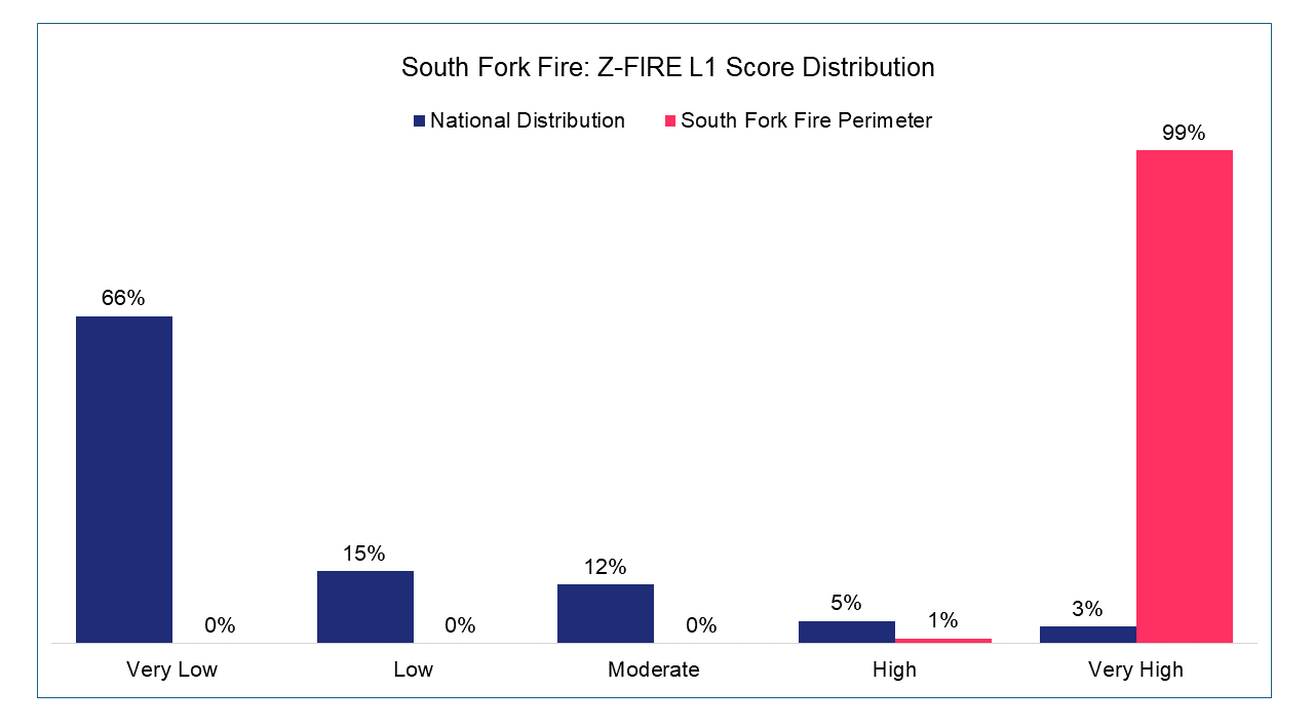

L2 Highlights Property-Specific Vulnerability
Property-specific characteristics significantly influence a structure's vulnerability during a wildfire event, even within the same neighborhood. While the entire South Fork Fire area exhibited high wildfire risk, mitigation efforts undertaken by property owners can significantly impact a structure's ability to withstand a wildfire.
The Z-FIRE L2 score quantifies this conditional risk, predicting the likelihood of a property being destroyed when exposed to a wildfire. The analysis revealed that approximately two-thirds of properties were classified as High or Very High risk for destruction, while the remaining third fell within the Low or Moderate risk categories.
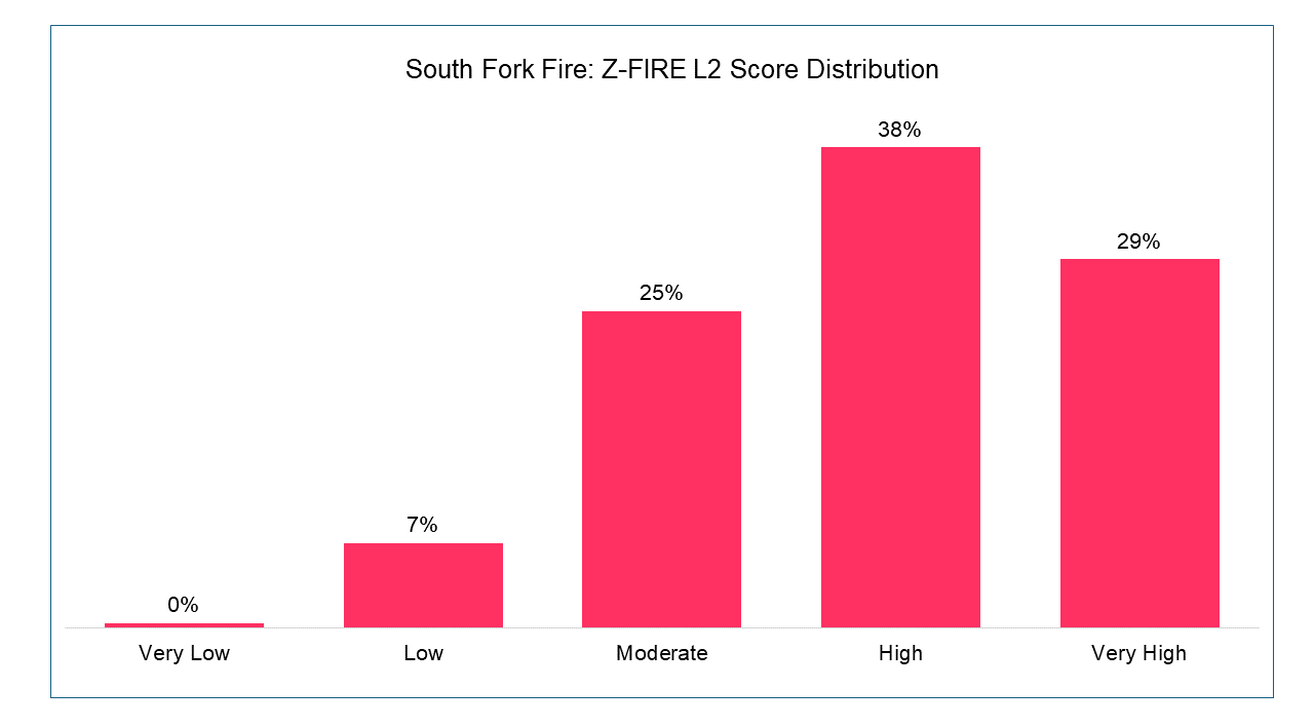
This variation in L2 scores underscores the importance of property-specific characteristics, such as maintaining defensible space and using appropriate roofing materials. Z-FIRE effectively highlights these variations, providing valuable insights for insurance carriers to collaborate with policyholders on implementing mitigation measures. After the fire is contained, we’ll analyze L2 score performance in predicting which structures survived as part of our 2024 Z-FIRE performance memo.
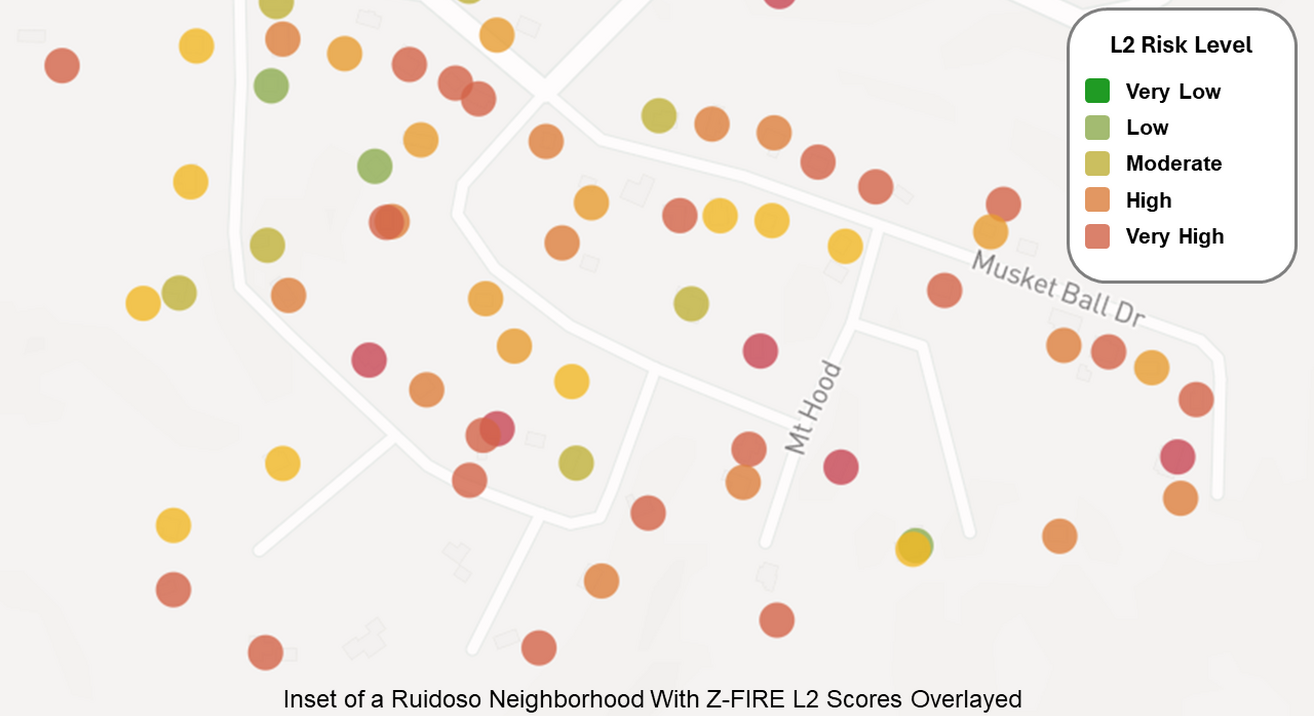
A Collaborative Approach to Wildfire Mitigation
Our research, conducted in partnership with the IBHS, confirms that fuel reduction efforts around a property can double its likelihood of surviving a wildfire event. This highlights the necessity of a multi-faceted approach that incorporates both property-level and community-wide mitigation strategies. For a deeper dive into this topic, we encourage you to explore our full research study, "Wildfire Fuel Management and Risk Management," alongside the 2024 Wildfire Season Overview.
Note: The Ruidoso fires is a rapidly changing situation. Numbers and analysis will change.
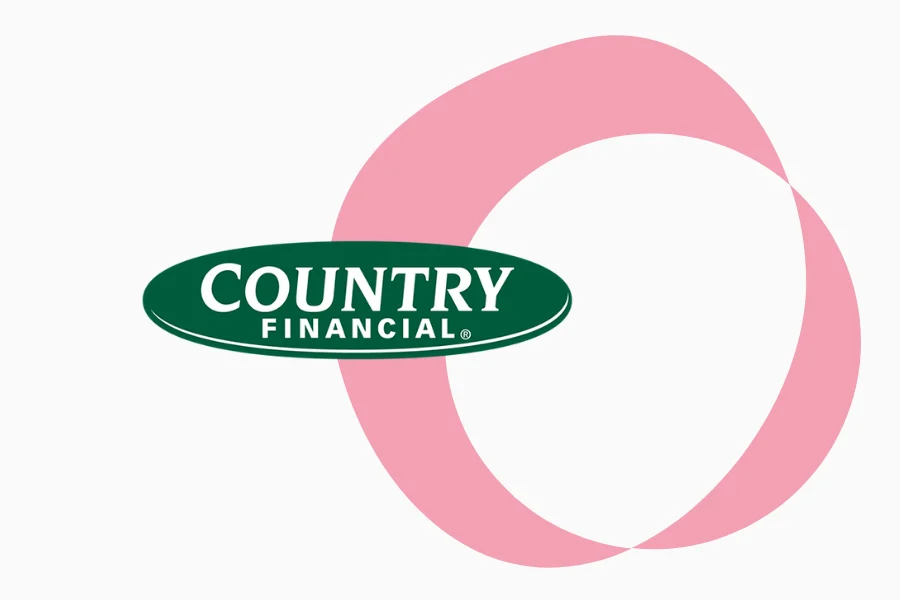
ZestyAI Welcomes COUNTRY Financial
ZestyAI products will be used to decrease processing time, increase transparency, and optimize inspection resources.
COUNTRY Financial's partnership with ZestyAI signifies a strategic move towards modernization and enhanced client service. By incorporating ZestyAI’s solutions into its underwriting processes, COUNTRY Financial is poised to streamline operations and provide more accurate risk assessments, aligning with its commitment to delivering unparalleled service to its valued clients and network of representatives.
By incorporating ZestyAI’s solutions into its underwriting processes, COUNTRY Financial is poised to streamline operations and provide more accurate risk assessments.
With ZestyAI's advanced analytics, COUNTRY Financial can offer clients and representatives a seamless, transparent, and accurate insurance experience, ensuring they receive the best coverage tailored to their needs.

ZestyAI Joins Duck Creek’s Solution Partner Ecosystem
Partnership Equips P&C Insurers With Best-In-Class Risk Information and Analytics
Today, ZestyAI, the leading provider of climate and property risk analytics solutions powered by Artificial Intelligence (AI), is announcing a strategic partnership with Duck Creek Technologies, the intelligent core systems provider defining the future of property and casualty (P&C) and general insurance. This collaboration will see ZestyAI’s entry into Duck Creek’s esteemed ecosystem as a Solution partner, equipping P&C insurers with the property analytics and peril-specific risk scores they need to assess and manage climate-related risks.
Record-breaking losses from natural disasters, like wildfires and severe convective storms, have left the P&C insurance industry searching for better ways of assessing and managing climate risk. ZestyAI, renowned for its expertise in harnessing artificial intelligence and data science to assess risk exposure at the property level, offers comprehensive property insights and climate risk models that account for all factors impacting a property's overall risk.
Key Benefits of the Integration
Comprehensive Climate Risk Assessment: ZestyAI's climate models accessible within the Duck Creek platform provide insurers with a holistic view of a property's risk exposure to natural disasters, such as severe convective storms and wildfires.
Enhanced Risk Management: With a more accurate understanding of property and climate risk, P&C insurers can reduce loss ratio through superior control over risk selection and offer tailored insurance solutions based on the insights provided by ZestyAI's climate models and property insights.
Faster, More Consistent Decisions: The integration of ZestyAI’s property and climate risk models into Duck Creek expedites personal lines and commercial lines workflows by facilitating straight-through processing of low risks, auto-declining high risks, and scaling underwriting capacity to where it’s needed most.
"We are delighted to partner with the strong team at ZestyAI to provide seamless access to their unique property data insights from within Duck Creek Policy," says Robert Fletcher, Sr. Partner Manager at Duck Creek. "Our mutual customers are looking for the most accurate, location-specific data to assess the underlying risk of a property. Through this new partnership with ZestyAI, we continue to demonstrate the power of Duck Creek's open platform, which enables insurers to rapidly integrate innovative solutions to provide an easier, quicker and more accurate user experience."
"We are delighted to partner with the strong team at ZestyAI to provide seamless access to their unique property data insights from within Duck Creek Policy"
“The insurance industry is undergoing a seismic shift when it comes to the availability of technology and data,” said Attila Toth, Founder and CEO of ZestyAI. “Our models are rooted in materials science and atmospheric science to tackle major challenges like wildfires and severe convective storms, in addition to general property risk assessments, like roof quality. We are pleased to be able to bring Duck Creek customers ZestyAI data, within their existing workflows for a better and more accurate approach to risk assessment.”
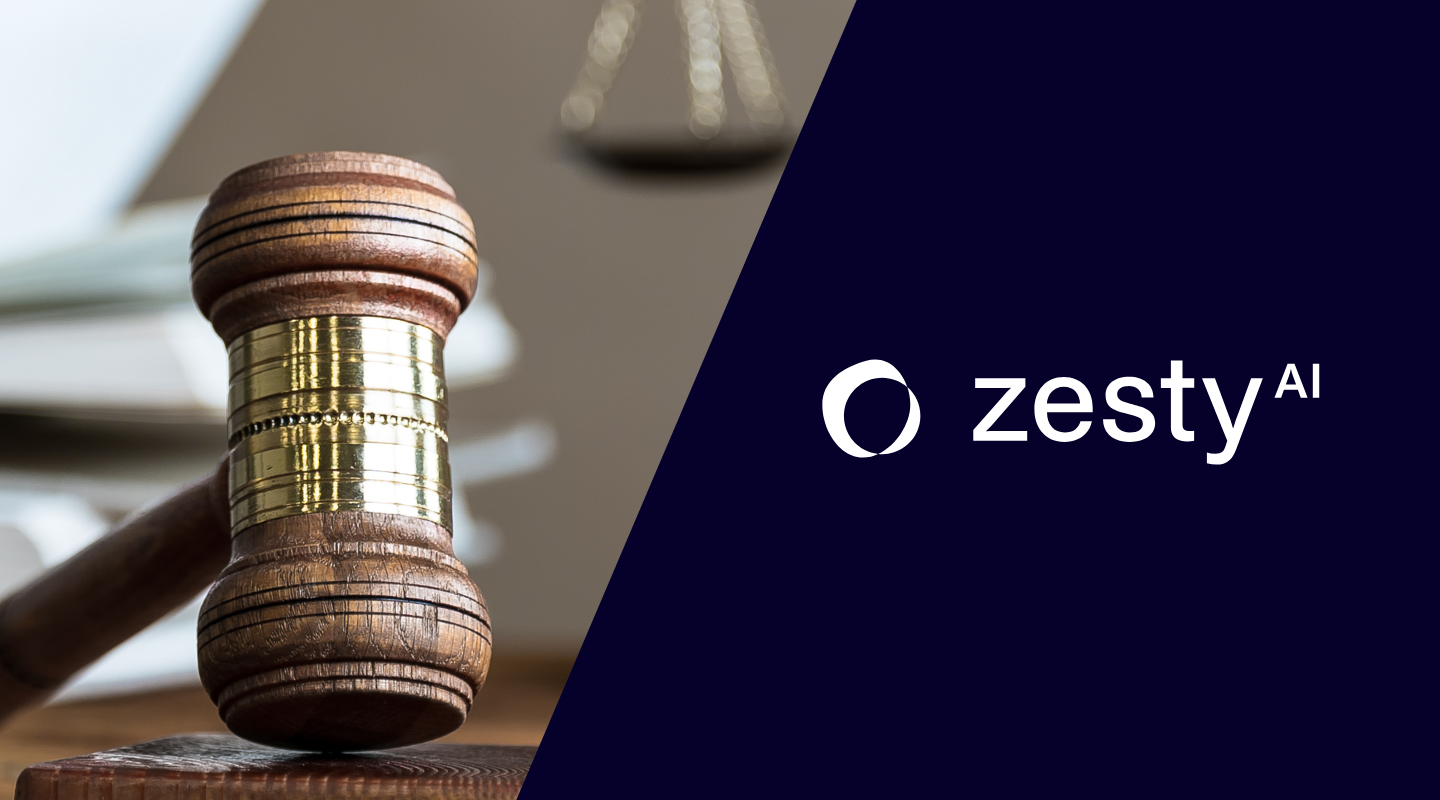
CDI Releases Draft Regulations on CAT Modeling and Ratemaking for Wildfire Risk
Proposed regulations allow catastrophe models to be incorporated into ratemaking in exchange for increasing availability in distressed areas.
ZestyAI is committed to leveraging advanced technologies, such as Artificial Intelligence, to predict and mitigate the societal impact of natural disasters. We believe robust governance and compliance are essential for successful AI adoption within the insurance sector. This includes not only understanding but actively shaping regulatory policy through a collaborative approach.
ZestyAI demonstrates this commitment by actively engaging with regulatory bodies. In July and October 2023, we presented solutions at the CDI Wildfire Workshop on how to leverage catastrophe models for improved insurance availability and affordability. Further, in April 2024, CEO Attila Toth provided recommendations for a clear and robust wildfire model review and approval process at the CDI's Catastrophe Modeling and Ratemaking Workshop.
We believe robust governance and compliance are essential for successful AI adoption within the insurance sector. ZestyAI demonstrates this commitment by actively engaging with regulatory bodies.
We are pleased to see the California Department of Insurance release a draft text of proposed regulations on catastrophe modeling and ratemaking aimed at increasing policy availability in high-risk wildfire areas.
Addressing Insurance Availability in Distressed Areas
The California FAIR Plan, acting as a last resort insurer, has seen a significant rise in the number of policies issued in recent years. Since 2019 the total dwelling policies in force have increased by 137% (source: CA FAIR Plan). This trend underscores the difficulties Californians face in securing traditional homeowners insurance.
The proposed regulations address this challenge by introducing market share quotas for insurers in designated distressed areas. These areas, encompassing entire counties or specific sub-regions, have been identified based on their reliance on the FAIR Plan. The draft proposes two alternative commitments for insurers:
- Increase their market share in distressed areas until it reaches 85% of their total market share in the state. This option is available for homeowners lines only.
- Increase the total number of policies written in distressed areas by 5%. This option is available for both homeowners and commercial lines.
Insurers must maintain detailed records of their policies in a wildfire risk portfolio, ensuring transparency and accountability in meeting their commitments. This includes regular reporting to the Department of Insurance on the number and location of policies written, as well as any changes in coverage. Comprehensive documentation will enable the Department to monitor compliance effectively and address any discrepancies or issues promptly. Insurers are expected to provide accurate and up-to-date information to facilitate ongoing assessment and oversight.
Insurers must maintain detailed records of their policies in a wildfire risk portfolio, ensuring transparency and accountability in meeting their commitments.
Commitments can be modified if carriers experience significant changes in market share, ensuring that their obligations remain proportionate to their business capacity. Additionally, insurers must attest to their progress in fulfilling their commitments in subsequent rate applications. This attestation involves a formal declaration of compliance, outlining the steps taken and policies written to meet the regulatory requirements. By providing this attestation, insurers affirm their adherence to the commitments and enable the Department to verify ongoing compliance and effectiveness of the regulation.
Balancing Market Expansion with Rate Adequacy: The Role of Catastrophe Models
The proposed regulations offer a potential incentive for insurers. In exchange for meeting market share quotas in distressed areas, carriers can leverage forward-looking catastrophe models to project average annual wildfire losses. This data can then be used to support a justified rate increase application.
ZestyAI believes this integration of catastrophe models into rate applications holds promise. It could enable the expansion of insurance options for homeowners while promoting long-term rate stability. The CDI's announced requirement for higher home acceptability in distressed areas aligns with this approach and represents a positive step.
This could enable the expansion of insurance options for homeowners while promoting long-term rate stability.
Rate adequacy is a core principle of insurance carrier profitability, ensuring premiums charged by insurers are sufficient to cover future losses and expenses. To achieve this, rate applications rely on assumptions reflecting the carrier's anticipated future risk exposure. If insurers are expected to take on more wildfire risk, it stands to reason that their assumed wildfire losses should reflect this increased average exposure. Catastrophe models can inform carriers about their future risk profile based on the anticipated written exposures, including potential market share expansion in distressed areas.
The Need for Improved Rate Segmentation
Increased risk exposure in fire-prone distressed areas is an inherent consequence of expanding insurance availability. However, implementing risk segmentation strategies, such as those offered by ZestyAI's Z-FIRE solution, can generate significant benefits for both insurers and policyholders.
Risk-based rating and segmentation enable most consumers to benefit from potentially lower premiums based on their individual risk profile. This approach also promotes greater market access for all. Additionally, increased home acceptability in distressed areas allows admitted insurers to reduce the burden on the FAIR Plan, ultimately reducing the overall assessment risk for the admitted market and fostering long-term market stability.
Property-specific features play a critical role in determining wildfire damage susceptibility, even within localized areas. ZestyAI's Z-FIRE Level 2 (L2) score quantifies this risk by predicting the likelihood of a property sustaining damage during a wildfire event. Properties with the lowest L2 score possess a 5% chance of burning, while those with the highest score face an 88% chance of being consumed.
Property-specific features play a critical role in determining wildfire damage susceptibility, even within localized areas.
A review of historical wildfire data, specifically focusing on the 2022 California fire season, reveals that just 37% of properties within designated wildfire perimeters fell within the high-to-very-high L2 risk category. This finding suggests a substantial opportunity for identifying properties with lower risk profiles (63% falling within the low-to-moderate risk categories) even within regions traditionally considered highly susceptible to wildfires.
ZestyAI: Committed to Shaping Regulatory Policy
ZestyAI is dedicated to leveraging artificial intelligence for a more resilient future. We believe in robust governance and compliance to foster successful AI adoption within the insurance industry. We actively participate in shaping regulatory policy, advocating for a collaborative approach that fosters both innovation and regulatory compliance.
ZestyAI will present at the upcoming workshop on June 26th. We look forward to discussing these critical issues with you.
Bryan Rehor is Director, Regulatory Strategy, at ZestyAI
Ready to see how ZestyAI works on your book of business?
Tell us a little about your needs. We'll show you how we reduce losses and help you price with precision.








